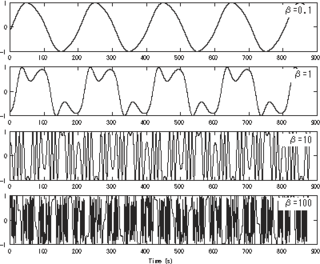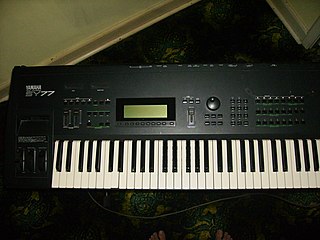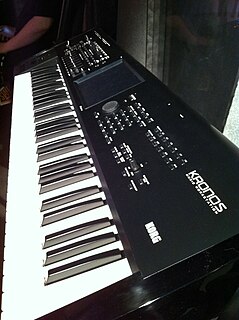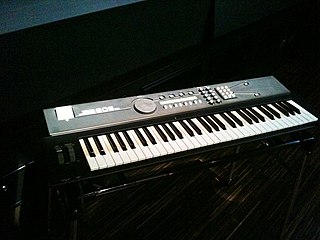
A digital synthesizer is a synthesizer that uses digital signal processing (DSP) techniques to make musical sounds. This in contrast to older analog synthesizers, which produce music using analog electronics, and samplers, which play back digital recordings of acoustic, electric, or electronic instruments. Some digital synthesizers emulate analog synthesizers; others include sampling capability in addition to digital synthesis.

An electronic musical instrument is a musical instrument that produces sound using electronic circuitry. Such an instrument sounds by outputting an electrical, electronic or digital audio signal that ultimately is plugged into a power amplifier which drives a loudspeaker, creating the sound heard by the performer and listener.

Frequency modulation synthesis is a form of sound synthesis whereby the frequency of a waveform is changed by modulating its frequency with a modulator. The frequency of an oscillator is altered "in accordance with the amplitude of a modulating signal".
Physical modelling synthesis refers to sound synthesis methods in which the waveform of the sound to be generated is computed using a mathematical model, a set of equations and algorithms to simulate a physical source of sound, usually a musical instrument.

Digital music technology encompasses digital instruments, computers, electronic effects units, software, or digital audio equipment by a performer, composer, sound engineer, DJ, or record producer to produce, perform or record music. The term refers to electronic devices, instruments, computer hardware, and software used in performance, playback, recording, composition, mixing, analysis, and editing of music.
A software synthesizer, also known as a softsynth or software instrument, is a computer program or plug-in that generates digital audio, usually for music. Computer software that can create sounds or music is not new, but advances in processing speed now allow softsynths to accomplish the same tasks that previously required the dedicated hardware of a conventional synthesizer. Softsynths may be readily interfaced with other music software such as music sequencers typically in the context of a digital audio workstation. Softsynths are usually less expensive and can be more portable than dedicated hardware.
A music workstation is an electronic musical instrument providing the facilities of:

Reason is a digital audio workstation for creating and editing music and audio developed by Swedish software company Reason Studios. Reason emulates a rack of hardware synthesizers, samplers, signal processors, sequencers, and mixers, all of which can be freely interconnected in an arbitrary manner. Reason can be used either as a complete virtual music studio or as a set of virtual instruments to be used with other sequencing software in a fashion that mimics live performance.

The Yamaha DX7 is a synthesizer manufactured by the Yamaha Corporation from 1983 to 1989. It was the first successful digital synthesizer and is one of the bestselling synthesizers in history, selling over 200,000 units.
A rompler is an electronic music instrument that plays pre-fabricated sounds based on audio samples. In contrast to samplers, romplers do not record audio and have limited or no capability for generating original sounds. The term rompler is a portmanteau of the terms ROM and sampler. Both may have additional sound editing features, such as layering several waveforms and modulation with ADSR envelopes, filters and LFOs.
The Yamaha AN1x is a DSP-based analog modeling synthesizer, produced by Yamaha Corporation from 1997 to 1998, and was marketed as an "analog physical modelling control synthesizer".

The Korg Wavestation is a vector synthesis synthesizer first produced in the early 1990s and later re-released as a software synthesizer in 2004. Its primary innovation was Wave Sequencing, a method of multi-timbral sound generation in which different PCM waveform data are played successively, resulting in continuously evolving sounds. The Wavestation's "Advanced Vector Synthesis" sound architecture resembled early vector synths such as the Sequential Circuits Prophet VS.
Linear Arithmetic synthesis, or LA synthesis, is a term invented by the Roland Corporation when they released their D-50 synthesizer in 1987.

Yamaha SY77 is a 16 voice multitimbral music workstation first produced by Yamaha Corporation in 1989. The SY77 is a synthesizer whose architecture combines AFM synthesis, AWM2 for ROM-borne sample-based synthesis, and the combination of these two methods christened Realtime Convolution and Modulation Synthesis (RCM). The same technology was also packaged in a rack-mounted module released simultaneously, the TG77.

A synthesizer is an electronic musical instrument that generates audio signals. Synthesizers generate audio through methods including subtractive synthesis, additive synthesis, and frequency modulation synthesis. These sounds may be shaped and modulated by components such as filters, envelopes, and low-frequency oscillators. Synthesizers are typically played with keyboards or controlled by sequencers, software, or other instruments, often via MIDI.

The Korg RADIAS is a virtual analog synthesizer and Vocoder, released by Korg in 2006. The RADIAS' MMT engine was based on the Korg OASYS synthesizer module, providing for several different synthesis methods, two of which may be combined in a single voice e.g. phase distortion synthesis can be combined with subtractive synthesis. The different synthesis methods employed by MMT represent the majority of methods used historically in other Korg synthesizers: digital waveguide synthesis Korg first used in the Korg Z1 and phase distortion synthesis was first used in the Korg DS-8. This flexibility allows for very realistic emulations of past Korg synthesizers, though stays away from trying to emulate the Korg M1 and the Korg Wavestation,. As well as using the in-built waveforms for the basis of sound creation, the RADIAS allows for the input of an external signal which may be routed through the various sound shaping devices. The RADIAS has a comprehensive matrix modulation specification and to further enhance a sound the 'Wave Shaper' module allows for various sound distortion effects.

The Kronos is a music workstation manufactured by Korg that combines nine different synthesizer sound engines with a sequencer, digital recorder, effects, a color touchscreen display and a keyboard. Korg's latest flagship synthesizer series at the time of its announcement, the Kronos series was announced at the winter NAMM Show in Anaheim, California in January 2011.

The Yamaha YS200 is an FM synthesiser and workstation produced by Yamaha, introduced in 1988. It combines a sequencer, rhythm machine, a FM synthesis soundchip and a MIDI keyboard. It was called the EOS YS200 in Japan and was also released as a more home-oriented keyboard in the form of the Yamaha EOS B200, which also featured built-in stereo speakers. The YS200 is the keyboard equivalent of the Yamaha TQ5 module. The forerunner of the YS200 was the almost-identical Yamaha YS100.

The Yamaha DX21 is a digital bi-timbral programmable algorithm synthesizer with a four operator synth voice generator which was released in 1985. It uses sine wave-based Frequency Modulation (FM) synthesis. It has two FM tone generators and a 32-voice Random Access Memory (RAM), 32 user voices and 128 Read Only Memory (ROM) factory preset sounds. As a programmable synth, it enables users to create their own unique synthesized tones and sound effects by using the algorithms and oscillators. The instrument weighs 8 kg (17.6 lbs). On its release, it sold for $795.
The Yamaha DX9 is a spin off synthesizer of the family of the DX7 built by Yamaha. It uses FM synthesis and has 16 note polyphony; however, it only has four FM operators for sound generation compared with six on the DX7. It is the least complex of the DX range of synthesizers and has only 20 on board memory locations.












